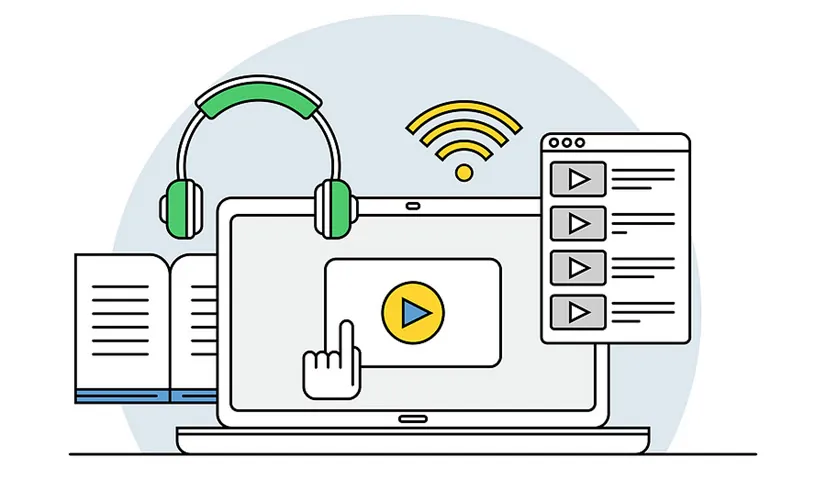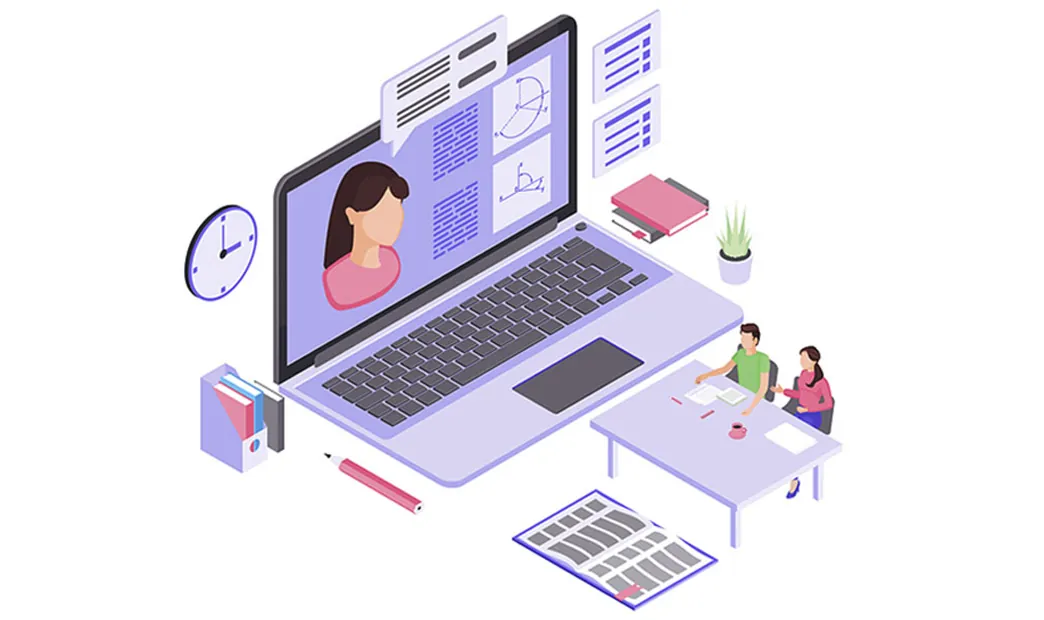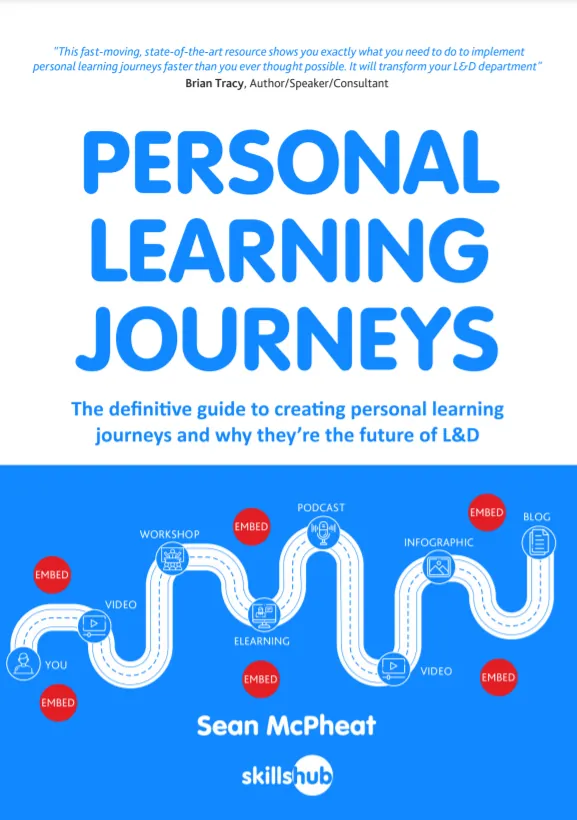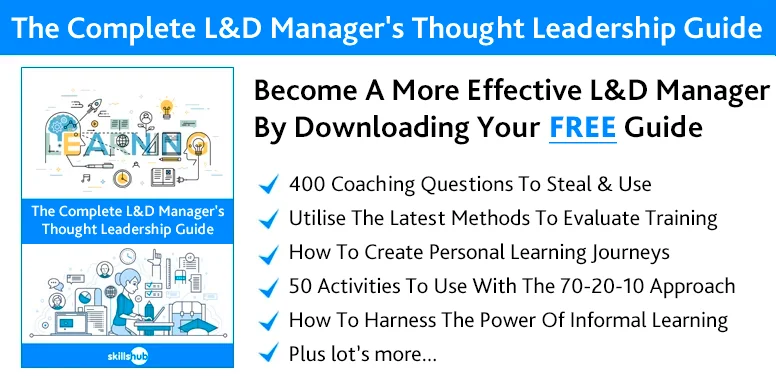
A learning experience platform (LXP) is a digital learning platform or tool which creates a learner-centric environment based around personalised learning journeys and content. As learning needs continue to evolve in today’s digital world, organisations need training methods that offer employees an engaging, flexible and intuitive experience. Traditionally, a learning management system is used to offer employee training, however, these can be slow to adapt to these changing demands whereas an LXP can recommend content based upon the goals of the learner and their skill level whether that be in the flow of work or via self-directed means.
Both LMS and LXP serve different organisational needs. LMS provides structured, compliance, based training, while LXP focuses on personalised, learner-driven experiences. Many organisations now seek one platform that combines the strengths of both LMS and LXP for streamlined management and a holistic learning strategy. As technology advances, learning systems are becoming more personalised and AI-powered, driving the development of new solutions for employee training.
Enter the learning experience platform (LXP). LXP platforms make learning content easier to find and consume. These platforms use artificial (AI) and are like YouTube or Netflix, giving learners personalised recommendations and allowing them to be in control of the learning experience.
In this post, we’ll cover what an LXP is, the role of AI, the differences between an LXP and an LMS, and the benefits of an LXP.

What is an LXP?
A learning experience platform (LXP) is an AI-driven learning software that aims to create more personalised learning experiences and help users discover new learning opportunities.
An LXP combines learning content from different sources and uses AI to recommend and deliver content to users. Key LXP functionality includes content discovery, AI-driven recommendations and content aggregation which allows learners to explore and personalise their learning journeys. LXP software also leverages advanced features such as analytics, integration capabilities and user-generated content to increase engagement and interactivity.
LXPs offer a new approach to corporate online learning platforms and addresses the limitations of learning management systems (LMS).
Learning experience platforms offer an intuitive learning experience, opportunities for professional development and a more independent, autonomous and self-directed style of learning.
What Enabled the Growth of Learning Experience Platforms?
A Learning Experience Platform (LXP) is a powerful tool to transform the way employees learn and develop within an organisation. Unlike traditional learning management systems which often focus on compliance and administrative tasks, a learning experience platform puts the learner at the centre of the experience.
LXPs offer a user-friendly interface and leverages advanced features such as content curation, machine learning and social learning to deliver a truly personalised learning journey.
By allowing users to explore content relevant to their interests and career goals, LXPs empower employees to take control of their own development. This not only supports the acquisition of new skills but also continuous learning and professional growth. As online learning becomes more important in today’s digital workplace, the learning experience platform LXP has become an essential part of any modern learning strategy.
By creating a learning culture that values collaboration, innovation and self-directed learning, LXPs help organisations stay agile and competitive in a rapidly changing world.

Learn How To Create Personal Learning Journeys For FREE!
Growth of the Internet and Mobile Technologies
As time goes on, the number of people using the internet on mobile devices to learn is increasing. As most consumers use the internet for most of their content consumption, it makes sense to offer people the opportunity to learn and expand their skills via digital channels. E-learning has become a core part of modern training, providing flexibility and accessibility for learners anywhere, anytime.
When people use LMS platforms, traditionally, they are used to meet company training requirements and not for the consumption of courses designed to help their development as individuals.
Outside of work, when people want to learn new things, what do they do? They go to the internet, watch videos or listen to podcasts.
Most of the time, they’re doing this through their mobile devices. Software as a service (SaaS) developers took note of this and started to create learning platforms that deliver experiences tailored to a user’s specific needs. Many of these platforms have been designed to meet the needs of mobile and digital learners.
Growth of user-generated content
People are creating new content all the time. Just log on to social media and look at your feed or do a Google search to see this in action.
Most of this content is designed to entertain users, drive ecommerce purchases or encourage social interaction. But a large chunk of this content is designed to educate consumers.
For example, if you want to learn more about a topic, you can type a question into Google or watch a YouTube video. The internet and mobile devices have changed how people learn. People no longer have to sit at a desk or go to a physical location such as a classroom, conference room or learning centre to gain new knowledge.
Consumers can now learn new information anytime and anywhere. They can search the internet. They can log onto social media and ask others about a topic, watch videos or read posts about a topic, or click on links to educational websites.
LXPs also allow users to create and share their own content, such as videos, documents or hyperlinks which can be commented on and rated by others, creating a collaborative learning environment. In addition to user-generated content, internal subject matter experts play a key role in contributing high-quality, specialised learning materials within LXPs.
LXP uses the same approach by leveraging user-generated content that’s characteristic of social and community-based learning.
Technological Revolution
New technologies like data analytics, AI, virtual reality (VR) and augmented reality (AR) make it easier to create high-quality content than ever before. Many modern LXPs have been built using these new technologies to enhance learning experiences. New technologies also make content creation more cost-effective within an LXP.
The Role of AI in an LXP
AI-driven LXPs can solve one of the many challenges learning and development (L&D) teams face: delivering training materials that bridge the skills gap employees have today.
AI makes the training experience more customised, intuitive and engaging. AI also helps L&D teams to use and leverage data to measure the impact of LXPs on organisational growth.
Virtual Training Assistant
Chatbots are growing in popularity, many companies are using them for conversational sales.
Language recognition is still in its infancy and isn’t yet mainstream. When companies adopt this solution, it will offer a conversational interface that will replace traditional text-based learning methods.
When using an LXP, learners will be able to use AI and chatbots to answer their questions and guide them through the platform.
Creating and Augmenting Content
For L&D teams, creating detailed training content that employees will retain can be a tedious task.
With AI, administrators don’t have to be responsible for creating and producing learning material for employees. AI can also automate the creation and management of eLearning content making it easier for L&D teams to deliver training through streamlined content distribution and AI can do this for you, most of the time.
Free Up Time and Resources
AI can guide employees to the right resources at the right time, making learning more efficient.
Learners will find out what they need to know as they need to know it. So instead of trying to fit them into training sessions that are time and space bound, they can self-learn over time as they take on different roles in the company.
Insights
There’s more to insights than just trend spotting and content curation. AI allows LXPs to encourage regular system use by gathering data on how a learner uses the LXP and how that compares to the average user.
For example, the platform can show learners if they’re checking in less often than the most successful learners on the platform.
AI can also show learners if they’re focusing too much on a particular topic or not spending enough time on a specific concept. By observing behaviour, AI can give feedback to learners so they can improve their experience on the platform.

LXP Features
User-generated Content
LXPs can use machine learning to choose and curate third-party data on the web and provide recommendations to users.
Data and Analytics
LXPs collect and store usage and learning data. Most platforms show this data in dashboards so employees can track their progress towards goals. This data also helps administrators understand learning and usage trends across the platform.
Modern UI or UX
LXPs are newer than LMS platforms. Plus, their UI is always online. So they provide a better UX and a platform that’s easy to use. A modern UI/UX directly enhances the learner’s experience by making the platform more intuitive and engaging, allowing users to easily discover content and stay motivated throughout their learning journey.
Building a Learning Culture
Building a learning culture is essential for organisations that want to succeed in today’s fast paced business world. A learning culture encourages employees to continuously develop their skills, share knowledge and adopt new ways of working. LXPs play a key role in creating this environment by providing a centralised platform where employees can access content, contribute user generated content and participate in collaborative learning experiences.
With LXPs, organisations can empower employees to own their learning, so users can engage with curated content that addresses current skills gaps and future development needs. The collaborative features of experience platforms encourage knowledge sharing and teamwork, so employees can develop essential skills and expertise together. By making learning accessible and engaging, LXPs drive higher levels of employee engagement, productivity and ongoing professional development. Ultimately, creating a learning culture with an LXP means a more adaptable, innovative and high performing workforce.
LXP Benefits
Now that you know what an LXP is and what the features are, let’s get into the benefits of an LXP.
Customised Learning Paths
LXPs try to meet a user’s individual needs as best as possible. Users can set their own learning goals, so they can tailor their development to their own interests and requirements. Through powerful search and recommendation functions, users can save time when looking for content and can more easily find the information they need to meet their goals.
Personalised learning paths within the LXP support career development by helping employees acquire new skills and move up the organisation. So employees get more out of the platform and administrators can manually configure training recommendations an LXP offers to employees.
Engaging Learning Environment
With a wide range of content types, LXPs can deliver more learning opportunities to users. LXPs accommodate different learning styles by offering different content formats and delivery methods, so training is engaging and tailored to individual preferences. This means more ways to engage users.
Employees Can Fit Training into Their Normal Workflow
Employees often don’t have much time to dedicate to formal learning. This can stop them from learning new skills that can help them succeed at work.
An LXP offers fast, informal and flexible learning that employees can easily fit into their schedule. So they can learn “in the flow of work”.
While working, they can get quick answers that meet them at their point of need and throughout the workday.
Social Learning
According to a LinkedIn study, a large proportion of employees feel more motivated when their colleagues are around them.
Platforms like LinkedIn Learning integrate with LXPs to offer a massive library of courses, social learning, and skill-based recommendations for both corporate training and individual upskilling.
LXPs allow employees to interact with other learners, which adds a new dimension to eLearning. Using an LXP, learners can share their different perspectives and what they’ve learned with others.
For example, users can create and share eLearning content, custom playlists, blogs, videos, webinars, articles and other learning content from any device.
This allows them to create collaborative workspaces in platforms like Microsoft Teams and Slack where groups can come together for shared learning.
Collaboration can improve employee knowledge and skill which can lead to better performance and productivity.
Admins can get in the mix too. When employees ask specific questions, L&D teams can jump in and offer their expertise on a particular topic.
Plus when users are creating comments and interacting on forums within the LXP, it helps the AI within the platform to better understand each user and as a result deliver content to them that’s relevant and engaging.
Dynamic and Intuitive Features
LXPs are easy to use and offer plenty of opportunities for collaborative engagement. A modern LXP should have the following features: content curation, analytics, integration capabilities, content creation, chatbots and gamification. These essential components streamline the learning process for employees.
For example gamification or gaming mechanics increase engagement and competition. This includes leaderboards, badges, achievements and special privileges.
Mobile Accessibility
More and more people are using their mobile devices to complete day to day tasks so it’s crucial that learning platforms offer this.
LXPs come with mobile learning apps so employees can use them at times that suit them and wherever they are.
They can complete their course at the office, at home or on weekends without interruption.
This is on-demand learning. When employees feel in control of how they learn they’ll focus more on the content and as a result retain the information.
High ROI
Because LXPs offer continuous learning this can boost productivity and performance on the job. Because employees are constantly learning new skills. When employees are productive and performing at high levels this can increase your ROI. Some platforms even come with ROI software and calculators based on the Kirkpatrick Evaluation Model.
When employees can collaborate with their colleagues it can also improve work performance. Organisations with high employee engagement see a 19% increase in the business’ operating income.


What’s the difference between an LMS and an LXP?
An LXP is a learner centric platform where the user can choose their own learning from a diverse array of personalised content.
On the flip side a learning management system (LMS) allows admins to assign and track highly structured content.
In other words, in an LXP users can choose which content they can use for learning based on their preferences and learning style. This means LXP users are in control of their own learning experiences and can tailor it to their training needs.
In a nutshell an LXP puts the user first and lets them be in control of the learning experience whereas an LMS puts the admin in charge of the content the user will consume for learning.
Learning Experience Platforms in Practice
Learning experience platforms are being adopted by organisations across a wide range of industries from education and healthcare to finance and technology. In practice LXPs support a variety of learning initiatives such as onboarding new hires, developing leadership capabilities and promoting internal mobility.
For example LinkedIn Learning’s LXP uses data driven insights to curate content and help employees upskill in areas that matter most to their roles. Similarly, platforms like Degreed and Juno offer personalised learning experiences that adapt to each learner’s needs and preferences.
By integrating LXPs with existing learning management systems and other management systems organisations can create a seamless learning experience that gives employees access to a vast array of resources and tools. This integration supports performance management by allowing managers to track learner progress, identify strengths and areas for improvement and align learning to business objectives.
Whether it’s supporting the development of new skills, facilitating internal mobility or enhancing the onboarding process for new hires LXPs are helping organisations create, deliver and manage impactful learning experiences that drive real results.
Let’s look at the key features of an LMS vs LXP:
Learning Management System (LMS)
- Traditional approach
- Admins assign training to users
- Host very specific type of content based on compliance
- Don’t encourage social learning
- Usually caters to corporate learning needs
- Confines the learning experience to a defined curriculum
- Don’t incorporate resources from third-party providers
- Use “push learning” where administrators deliver content to learners
- The experience is like going to a cinema (the cinema chooses the content a user consumes)
Learning Experience Platform (LXP)
- Newer term, but a growing market
- Users pick their own learning based on personalised recommendations
- Host a wide range of content formats and types
- Encourage and allow social learning
- Usually caters to the user’s learning experience
- Offers an open-ended discovery platform that employees are in control of
- Open systems that freely permit third-party content sharing and creation
- Use “pull” learning where it puts the learning at the centre of the experience
- The experience is like going on YouTube (the user is in control of the content they consume through using search)


Choosing the Right LXP
Choosing the right learning experience platform is a big decision for any organisation looking to build a learning culture. When evaluating LXPs consider how well the platform integrates with your existing systems, the quality of the user interface and user experience and how it delivers personalised learning through features like content curation, machine learning and social learning.
Look for an experience platform that offers robust analytics and reporting so you can measure learner progress and the impact of your learning initiatives. Scalability, security and support for mobile learning are also key factors as is the platform’s ability to incorporate both internal and external resources.
By assessing these elements and aligning your choice with your organisation’s needs you can choose an LXP that supports development and engagement and drives business growth. The right LXP will empower your employees, improve continuous learning and help your organisation stay ahead in an ever-changing world.
Will the LXP Replace the LMS?
According to Gartner users want a more bite-sized delivery of learning assets and more ways to be in control of the content they consume. So, it’s no surprise that companies are spending more on LXP platforms. Giving employees more control over their learning is a great way to boost engagement.
However, in many organisations the need to deliver more formal learning content is still there. Think of the health and safety industry for example where compliance plays a big role in their operations. An LMS will still be required to provide employees with more specialist knowledge.
So think of an LXP as an extension of an LMS. In other words, LXPs improve the learning experience and make it more engaging when administrators pair them with an LMS.
When you combine both approaches employees will get mandatory and statutory training but in a more personalised way.
Conclusion
Many organisations have asked for an employee training solution that’s cost effective, scalable and has features for measuring progress and results.
LXP brings social learning and adaptivity to the employee and L&D team’s experience. Adaptivity is a key part of increasing employee engagement and a fundamental part of any company’s training strategy which is at the heart of an LXP.
With learners who want more personalised experiences and on-demand content an LXP is the recipe for modern learning. Using artificial intelligence, the advanced solution can deliver a learning ecosystem that drives growth for the modern enterprise and employee.
As an eLearning company, Skillshub is committed to creating effective and impactful learning experiences.
We’re Learning and Development experts with a passion for helping businesses tailor their online training to the needs of your team. So whether it’s bespoke learning or an LMS we can help you.
















